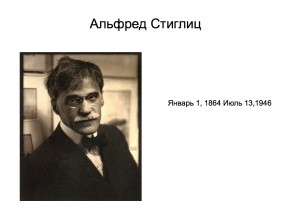Olga Ivanova presented her paper on Alfred Stieglitz at a conference in Gzhel, Russia in November 2012. The paper was delivered in Russian and based on research in a graduate seminar taught by Craig Eliason.
My first presentation of a research paper at an academic conference was in Russia, and I found this experience both rewarding and challenging. I came across the listing for the Conference in Gzhel, Russia in early October 2012 and I was quite surprised to see that they were still accepting submissions. The Conference was to take place on November 22-23. The organizing committee accepted my paper and proved to be very resourceful about getting me into the program and answering all my questions in a timely manner. My main concern was about the presentation style and their technical capabilities. I was assured that most presenters use PowerPoint and stick to a script, which was a relief to me for presenting a paper in Russian.
I presented research that I had started in Craig Eliason’s graduate seminar, American Painters of the Gilded Age. Though the conference mentioned it was “international,” they requested that I present in Russian. I was eager to take on the challenge of translating my paper. While I speak Russian fluently, I don’t have a strong technical vocabulary in art history, and I had to consult dictionaries and various art publications in Russian in order to make appropriate translations of terms. Another limitation was that I could not practice my presentation and get feedback on it since no one in the program spoke Russian (I would strongly encourage everyone to present to faculty and colleagues before a conference).
Gzhel is located about 60 kilometers outside of Moscow and I took an early morning train to get there on time. I was given very detailed instructions and had no problem finding the university. Gzhel University is famous for it unique style of ceramics that is painted solid white with distinctive blue designs, all made by hand. Together with other guests, I was given a tour of the University’s art gallery and the studio where the ceramics are produced. After a welcoming speech, the conference broke into sections. There were fifteen presenters in my section, fourteen on Russian art. I was scheduled to be tenth, but the Dean unexpectedly gave me the honor of presenting first. I was the only international student who had travelled from far away, and it was their way of showing their appreciation for my interest. Believe it or not, but I was really thankful for this gesture, after my initial shock. Since I did not expect to be presenting right away, I was somewhat relaxed. Though I am genuinely terrified of public speaking, I felt calm and confident during the presentation and I was asked a number of questions, mostly about the logistics of conducting the research in the USA. I think it was a combination of various factors that made my presentation successful: I put a lot of effort and time into the research and translation, which added to my confidence during the presentation, and I was frankly excited to share it with other art historians and to hear their opinions. I was thrilled to see that my presentation was received so well, and more thrilled that I was awarded a second place prize in my section.
One difficulty was that during my presentation, I couldn’t control my PowerPoint from a remote at the presenter’s stand and had to ask the tech guy to switch the slides for me as I was presenting. I found that distracting, especially because I tend use transitional slides in the middle of sentence. Other presenters, however, were used to present in this manner of calling for the next slide rather than using a remote control.
The scope of topics at the conference was broad, but they were mostly concentrated on the art of the 20th century, so my photography research fit nicely. I found that the Russian presentation style was more casual and many presenters didn’t follow their script. This did make some presentations rather longer than scheduled, unfortunately. Overall I found that Russian art historians conduct brilliant research, and I was happy to make some contacts.
After the presentations, I socialized with other presenters and the organizing committee during the reception hour. I met many fascinating people who were interested to learn about UST and its art history program. One day, I hope to see some of them at our own annual Graduate Art History Symposium.
In addition to participating in this conference, I conducted research at the Russian State Documentary Film and Photo Archive at Krasnogorsk (outside of Moscow) and at the State Archive of Documentary Films, Photographs, and Sound Recordings (St. Petersburg). I collected some important resources that will serve as a foundation for my Qualifying Paper this spring. I look forward presenting my research at the UST Graduate symposium in May.
Since my Powerpoint presentation was in Russian, I doubt this information will be practical. Nevertheless I am attaching a PDF below of my presentation for your review. I am happy to discuss it further if anyone is interested!

